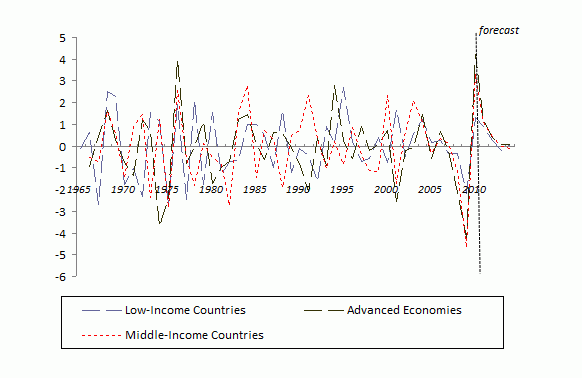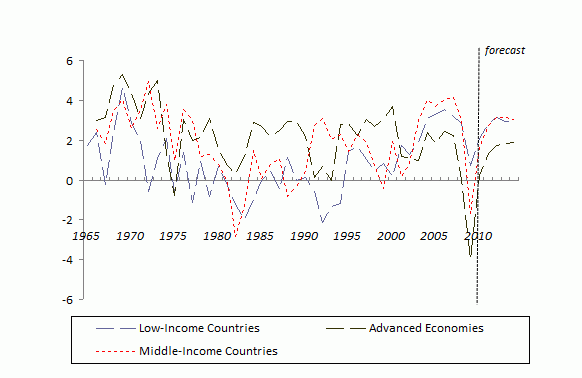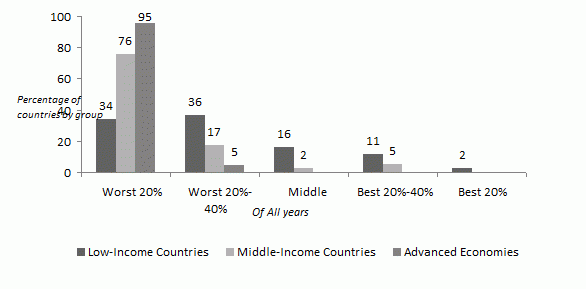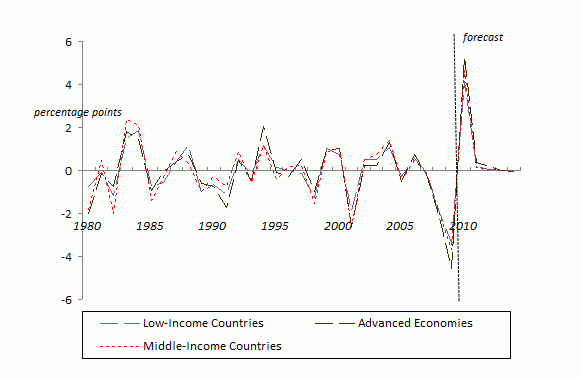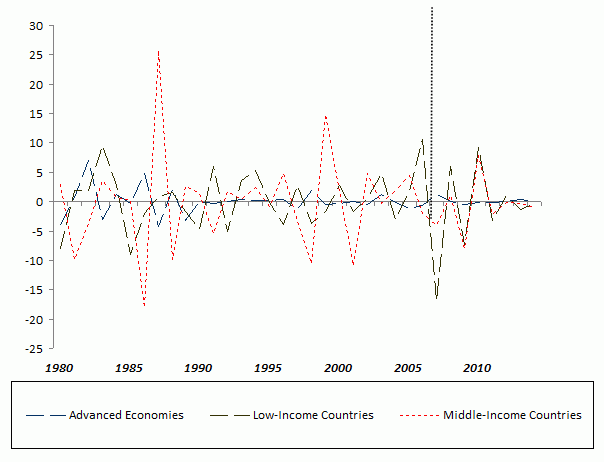The existing research on the impact of the global financial crisis has tended to focus mainly on advanced countries and emerging markets (see for instance, Berkmen et al. 2009; Blanchard et al. 2010; IMF 2010; Lane and Milesi-Ferretti 2010; and Rose and Spiegel 2009). But the global financial crisis that started in 2007 raises several important questions for low-income countries (LICs).
- First, what will be the short-run effects on growth in LICs, and what are the key transmission mechanisms?
- Second, are the effects different from those in middle-income countries (MICs)?
- Third, how do the effects depend on policies and country characteristics?
- Finally, how do the answers change when considering the medium- to long-run?
In two recent working papers with colleagues at the IMF, I focus on answering these questions (Berg et al. 2010, 2011).
The global crisis in low-income countries
Let us start by examining some stylised facts. In 2009 and 2010, the crisis did indeed substantially slow growth in LICs. The impact was smaller than in advanced economies but, for LICs as a group, 2009 nevertheless represented the biggest shock to growth since the 1970s (Figure 1). That said, LICs as a group had enjoyed relatively rapid growth during the first decade of the 2000s. As a result, even at the trough of the crisis, their average growth rate remained high by historical standards (Figure 2).
Figure 1. Change in output growth rate (percentage points)
Figure 2. Output growth rate (percentage points)
Perhaps surprisingly, for many individual LICs 2009 does not stand out as an extraordinarily calamitous year. In contrast, for most individual MICs and advanced economies, 2009 saw an extraordinarily deep recession. Figure 3 illustrates this. It is constructed by first computing, for each country, the change in output growth rates between 2007 and 2009. This change is then compared with the entire distribution of annual changes in output growth rates for that country since 1970. For most advanced economies, 2009 clearly ranks among the worst 20% of all years in the period (indeed, for many countries, it is the single worst year). For most LICs, in contrast, 2009 does not rank among the worst years. This arises in part because the growth decline in LICs was smaller than in MICs and advanced economies. It also reflects the generally volatile nature of the growth process in many LICs.
Figure 3. 2009's ranking in 40 years of annual growth rates
As pointed out, 2009 saw the worst growth decline since the 1970s for LICs as a group, but it did not represent a particularly bad year for most individual LICs. These two facts can be reconciled by noting that 2009 was different in an important way: output declines within (as well as across) all the main country groups were much more highly synchronised than during any previous year, reflecting the global nature of the crisis (Figure 4). Much of the usual growth volatility in LICs stems from idiosyncratic and domestic shocks (such as wars, weather, policy shocks, and political crises). The synchronisation displayed in 2009 was thus highly unusual, even if the size of individual countries’ growth shock was not.
Figure 4. Average bilateral correlations of real GDP per capita growth, 1965–2009
Next, let us turn to some potential drivers of the output decline in LICs. The year 2009 saw an unusual collapse in external export demand, both in the aggregate and for most individual economies – the “Great Trade Collapse”, described by the VoxEU eBook (Baldwin 2009). As shown in Figure 5, the aggregate declines in external demand growth for advanced economies, LICs, and MICs were sharper in 2009 than in any other year in the dataset. Similar conclusions hold for individual economies within each of the above groups. Indeed, for every economy in the sample, 2009 ranked among the worst 5% of all years in terms of the change in the growth rate of external demand.
Figure 5. Change in growth rate of external demand
In contrast, when examining the changes in the external terms of trade or in capital inflows, the period 2007-2009 does not stand out as exceptionally negative. LICs’ overall terms of trade declined, but the declines were concentrated in fuel exporters, while fuel importers saw no decline (Figure 6). Meanwhile, FDI into LICs declined on average by amounts that were large by historical standards but still fairly small relative to GDP.
Figure 6. Changes in terms of trade
(a)
(b)
Not surprisingly then, the formal econometric analysis in our papers (based on both cross-sectional and panel regressions) confirms that changes in external demand were a key driver of the output decline in LICs during the global financial crisis. That said, much of the cross-country variation in growth performance over the period could not be explained purely by external shocks, including shocks to external demand.
The papers also explore whether the cross-country growth variation during 2007-2009 is attributable to the policy regimes in place and/or to institutional and structural features of the relevant economies. Two findings are worth highlighting.
- First, in LICs (as well as in middle-income countries), greater external reserves helped buffer the impact of large negative shocks to external export demand. This buffer effect, however, tended to diminish or disappear at high reserve levels.
- Second, greater structural flexibility, and in particular greater labour-market flexibility, was broadly associated with a smaller impact of external demand shocks and helped reduce the impact of large negative shocks. Put differently, economic flexibility does not just improve long-run growth prospects – it also enables countries to adjust more effectively in response to crises. Perhaps surprisingly, most other results on policy were inconclusive. In particular, there was no robust link between the response to the crisis on the one hand, and on the other hand the exchange-rate regime (fixed versus flexible), pre-crisis fiscal deficits or debts, indicators of structural flexibility, or indicators of institutional quality.
As a final question, how persistent will the negative growth effects of the crisis on LICs prove? As mentioned above, the global financial crisis substantially slowed growth in most developing countries, thrusting millions back into poverty and setting back efforts to achieve the Millennium Development Goals. However, if the crisis also has long-run implications and affects countries’ long-term growth paths, then it will prove a much greater disaster.
To address this issue, the papers use several different methodological approaches, including impulse response function analysis, growth-spells techniques, and panel regressions. The analysis finds that shocks to external demand (that is, the type of shock that most impacted LICs during the global financial crisis) have historically been associated with quite substantial and highly persistent medium-run output losses. However, these shocks have not been associated with sharp declines in the underlying trend output growth rate.
Five conclusions
In summary, the empirical analysis yields five important conclusions:
- For many individual LICs, 2009 does not stand out as extraordinarily calamitous. The unusual element was the high degree to which output declines across LICs were synchronised.
- The sharp growth declines observed in LICs during 2007-2009 are on average well explained by the magnitude of the external shocks which they faced over the period, including in particular shocks to external demand – a factor ignored by most of the existing academic literature.
- If in the short run the external environment continues to improve, then growth in LICs is likely to continue rebounding.
- Cross-country differences in initial policies and in the structural environment explain only a limited share of the cross-country variation in growth experiences in 2007-2009. The two main exceptions are reserve coverage and labour-market flexibility, which helped countries adjust more effectively.
- Finally, shocks of the type observed during the global financial crisis have not historically been associated with sharp declines in the underlying output growth rate, providing grounds for (cautious) optimism about the LICs’ long-run prospects.
Ultimately, the analysis finds that, during the global financial crisis, LICs were impacted by a shock coming from outside. Further, the policy choices that had a clearest impact on the performance of LICs were the extent (within limits) of external reserves, and the degree of economic flexibility. All this suggests that the global financial crisis may hold fewer “novel” lessons for LICs than for advanced economies.
References
Baldwin, Richard (ed.)(2009), “The Great Trade Collapse: Causes, Consequences and Prospects”, A VoxEU.org Publication, 27 November.
Berg, A, C Papageorgiou, C Pattillo, and N Spatafora, 2010, “The End of an Era? The Medium- and Long-term Effects of the Global Crisis on Growth in Low-Income Countries,” IMF Working Paper 10/205 (Washington: International Monetary Fund).
Berg, A, C Papageorgiou, C Pattillo, M Schindler, N Spatafora, and H Weisfeld (2011), “Global Shocks and their Impact on Low-Income Countries: Lessons from the Global Financial Crisis”, IMF Working Paper 11/27.
Berkmen, P, G Gelos, R Rennhack, and J Walsh (2009), “The Global Financial Crisis: Explaining Cross-Country Differences in the Output Impact”, IMF Working Paper 09/280 (Washington: International Monetary Fund).
Blanchard, O, M Das, and H Faruqee (2010), “The Initial Impact of the Crisis on Emerging Market Countries”, mimeo, International Monetary Fund.
Drummond, P, and G Ramirez (2009), “Spillovers from the Rest of the World into Sub-Saharan African Countries”, IMF Working Paper 09/155..
Ghosh, A, J Ostry, and C Tsangarides (2010), “Exchange Rate Regimes and the Stability of the International Monetary System”, IMF Occasional Paper 270.
International Monetary Fund (2009), “The Implications of the Global Financial Crisis for Low-Income Countries”, IMF Policy Discussion Paper.
International Monetary Fund (2009b), “The Implications of the Global Financial Crisis for Low-Income Countries – An Update”, IMF Policy Discussion Paper.
Lane, PR, and G-M Milesi-Ferretti (2010), “The Cross-Country Incidence of the Global Crisis”, paper prepared for the IMF/BOP/PSE Conference “Economic Linkages, Spillovers and the Financial Crisis”, January.
Rose, A and M Spiegel (2009), “Cross-Country Causes and Consequences of the 2008 Crisis: International Linkages and American Exposure”, NBER Working Papers 15358.
